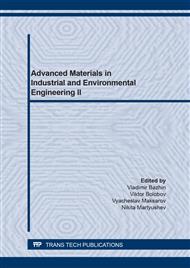p.8
p.15
p.21
p.28
p.35
p.41
p.47
p.55
p.61
Synthesis and Electron-Beam Modification of Zinc-Sulphide Phosphors for Solid-State Radioluminescent Light Sources (SRLS)
Abstract:
Radioluminescence technologies are at the front line of the optic and electronic studies. Effective, self-contained and safe radioluminescent light sources can find their application in space industry, in medicine and in military technologies. The question of the performance improvement of the solid-state radioluminescent light sources (SRLS) without raising the included activity of working radionuclide can be solved by upgrading the phosphor crystalline structure. The electron-beam treatment for zinc-sulphide phosphors initial batch has been studied in a wide range of concentrations of the activating agent (Cu) for improving the radioluminescent performances of the phosphors, for creating the structural defects that form centers of luminescence. The changes of the phase composition were investigated under different synthesis conditions. It is revealed that electron-beam treatment of the initial batch leads to the growth of the wurtzite phase content in zinc-sulphide phosphors synthesized below the phase transition temperature. The changes of the phase content promote the spectral redistribution under the tritium beta-excitation. It is obviously the reflection of the fact of «green» luminescence centers rearrangement between the volume of the crystal and its surface. The correlations between structural configuration and performances of ionizing luminescence were found. Electron beam treatment gave the 20% increase of brightness of the radioluminescence. The achieved enhancement of luminescence performances allows the development of advanced tight-packed SRLS with minimal radioactivity and high energy-light conversion.
Info:
Periodical:
Pages:
35-40
Citation:
Online since:
July 2021
Price:
Сopyright:
© 2021 Trans Tech Publications Ltd. All Rights Reserved
Share:
Citation:


